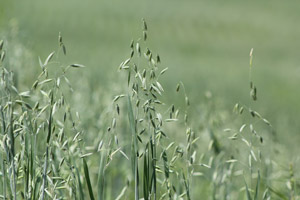Cover Crop Forages: The Nitrate Dilemma
September 2015

Planting cover crops such as brassicas and small grains during late summer or early fall is becoming a more common and accepted practice. Often these cover crops are grazed as a forage double crop. These species have been used as high quality forage for many years.
However, both the brassicas and small grains can accumulate high levels of nitrates. While the specific level at which nitrates become risky to cattle is unknown, most recommendations consider diets less than 3,000 to 5,000 ppm nitrates (NO3) as safe for all livestock, over 9,000 to 10,000 ppm nitrates as potentially toxic, and levels in between as risky for pregnant cattle.
Nitrate concentrations in excess of 20,000 ppm nitrates have been reported for these crops in recent years, especially for brassicas like turnips. Thus, many fields containing these forage double crops have appeared dangerous to use. Factors like high levels of soil nitrate, mineral imbalances, and growing conditions that slow plant growth like drought, frost, and cloudy weather can increase nitrate accumulation but these factors did not seem to fully explain the high levels measured in these cover crops.
Because of these high nitrate levels, many fields with large amounts of high quality, but potentially toxic, double crop forage were left unused. This certainly was a reasonable decision given the potential loss of life and financial loss that may have resulted from using the high nitrate forage.
Some producers, though, did use their forage double crops primarily by grazing despite the high risk of nitrate toxicity. Since there have been very few reports of losses due to nitrates from using these forages, it is apparent that much remains unknown regarding toxic levels of nitrates and using high-nitrate containing forages.
Brassicas and small grains should continue to be considered for use as forage double crops. Samples of the forage should be collected periodically, though, and tested for nitrate content. If high levels are detected, the safest alternative is to allow these high nitrate crops to remain as traditional cover crops until the next cropping season for soil and moisture conservation. Much of the N in the nitrates will remain for subsequent cropping systems.
If still used as forage, take appropriate steps to minimize losses. Risk of nitrate poisoning can be mitigated several ways. Nitrate poisoning is dose-dependent — both the amount and concentration of nitrate in the diet as well as how rapidly it’s consumed will influence the likelihood of toxicity. So avoid rapid consumption of high nitrate forages. Grazing and feeding strategies that either reduce the amount of nitrate consumed or spread its consumption across a longer time period will lower the chance of animals being harmed. These strategies may include any of the following:
- Adapt animals slowly to high nitrate forages.
- Graze pastures lightly to allow animals to selectively graze plant parts that are lower in nitrate concentration.
- Avoid feeding high nitrate forages to very hungry animals.
- Feed a probiotic that provides the rumen with microbes that convert nitrates to a non-toxic form.
- Dilute nitrate concentration by also feeding a low nitrate containing feedstuff.
- Feed grain to supply energy for rumen microbes to convert nitrate into bacterial protein.
- Feed frequent, small meals to spread out nitrate consumption.
- Ensiling forage often, but not always, reduces nitrate concentration 40 to 60 percent.
- Use extra care feeding high nitrate forage that has been ground due to rapid consumption and reduced selectivity.
If there are any concerns about the potential for nitrate toxicity, a reliable forage test will provide an indication of the management strategies needed. Even though the potential for nitrate toxicity exists, careful management can be used to reduce livestock losses.
For additional information on nitrates see the UNL NebGuide “Nitrates in Livestock Feeding” (PDF version, 319KB).
Daren Redfearn
UNL Forage and Crop Residue Systems Specialist
Bruce Anderson
UNL Forage Specialist